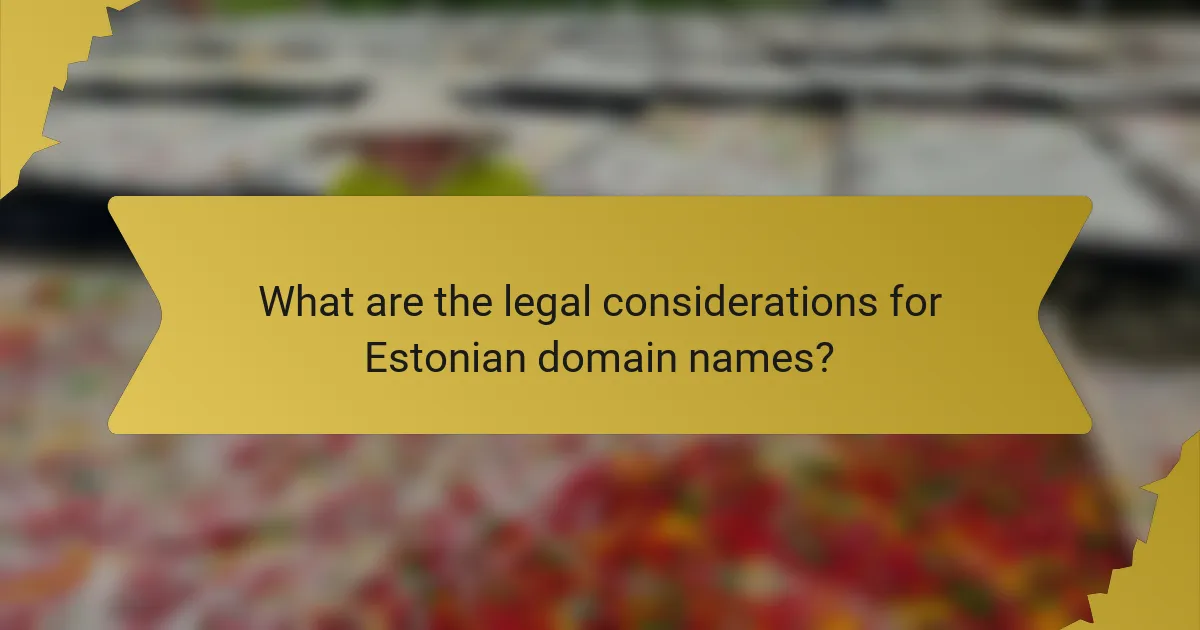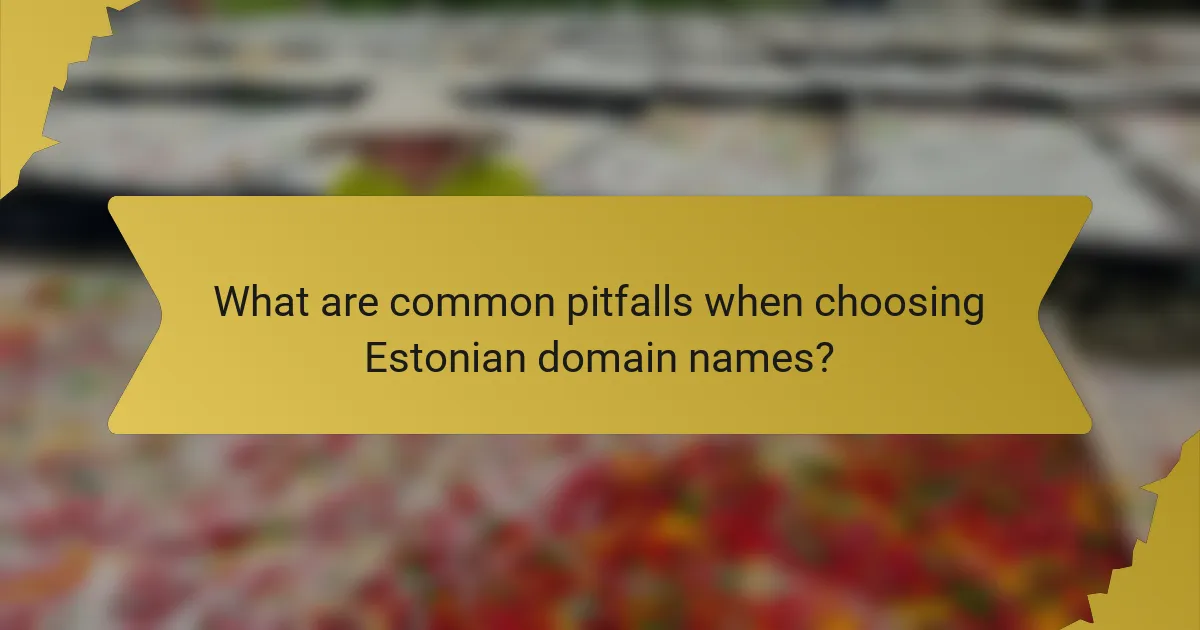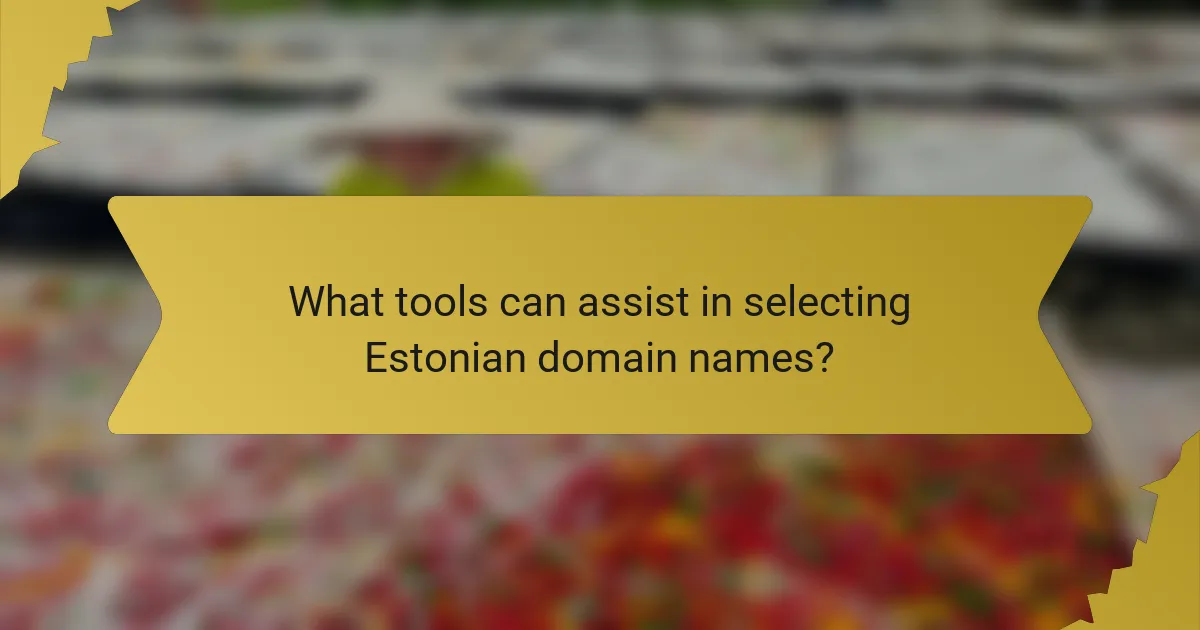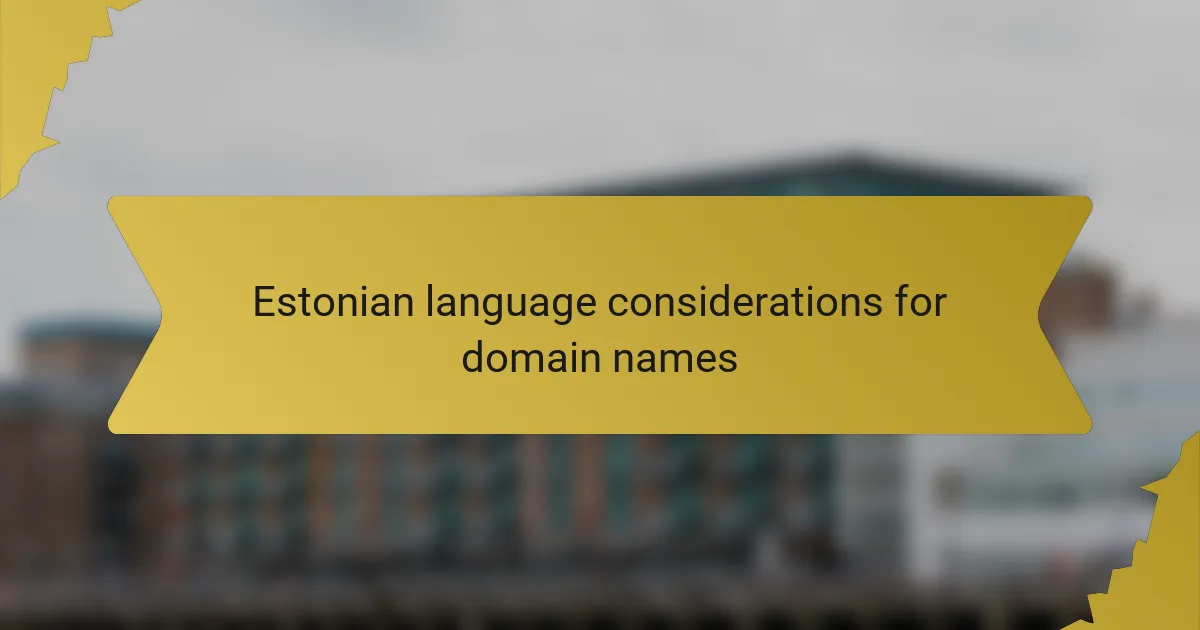When selecting a domain name in Estonia, it’s essential to consider the unique characteristics of the Estonian language, including local characters and cultural relevance. A well-chosen domain can significantly impact brand identity and visibility, making it memorable and appealing to the target audience. Additionally, adhering to legal regulations surrounding domain registration is crucial for establishing a successful online presence in the region.

What are the best practices for Estonian domain names?
Best practices for Estonian domain names include using local language characters, ensuring the name is concise and memorable, and aligning it with the target audience’s preferences. Additionally, considering SEO factors can enhance visibility in search engines.
Use of Estonian characters
Estonian domain names can include special characters unique to the language, such as š, z, and õ. Utilizing these characters can enhance local relevance and improve brand recognition among Estonian speakers. However, be cautious as some international users may have difficulty typing or remembering these characters.
For example, a domain like “kõik.ee” is more appealing to local users than “koik.ee,” but the latter may be easier for non-Estonians to remember. Weigh the benefits of local authenticity against potential accessibility issues.
Length and memorability
Keep Estonian domain names short and easy to remember. Ideally, aim for fewer than 15 characters to ensure users can recall and type the name effortlessly. Shorter names are also more visually appealing and can help with branding.
Avoid complex words or phrases that may confuse users. For instance, “parimtoit.ee” (best food) is straightforward and memorable, while “maitsvatoitjaerakond.ee” (delicious food and party) is cumbersome and less likely to be remembered.
Relevance to target audience
Ensure that your domain name resonates with your target audience in Estonia. Consider cultural references, local slang, and industry-specific terminology that may appeal to your demographic. A relevant name can foster trust and connection with users.
For instance, a domain like “tallinnatransport.ee” clearly indicates a transport service in Tallinn, making it immediately relevant to local users. Conducting audience research can help identify the most effective terms to use.
SEO considerations
Incorporate relevant keywords into your Estonian domain name to improve search engine optimization (SEO). This practice can enhance visibility in search results, attracting more traffic to your website. However, prioritize clarity and brand identity over keyword stuffing.
For example, a domain like “parimkohvik.ee” (best café) includes a keyword while remaining clear and brand-focused. Additionally, consider using a .ee extension, as it signals local relevance and can positively impact local search rankings.

How does language affect domain name selection in Estonia?
Language plays a crucial role in domain name selection in Estonia, influencing both visibility and brand identity. Choosing a domain name that resonates with the Estonian language can enhance recognition and trust among local users.
Impact of language on branding
The language used in a domain name can significantly affect a brand’s image and market positioning. A domain that incorporates Estonian words or phrases can create a sense of local relevance, making the brand more relatable to Estonian consumers. For instance, a domain like “parimtoode.ee” (best product) directly communicates value in the local language.
Additionally, using Estonian can differentiate a brand from competitors who may opt for English or other languages, potentially increasing customer loyalty. However, brands should avoid overly complex or difficult-to-spell words, as this can hinder memorability and accessibility.
Audience perception
Audience perception is heavily influenced by the language of a domain name. A domain that aligns with the local language can foster a sense of community and belonging, which is vital in Estonia’s close-knit market. Consumers are more likely to trust a brand that speaks their language and reflects their culture.
Moreover, using Estonian in a domain name can enhance search engine optimization (SEO) for local searches. This can lead to higher visibility in search results, as Estonians often search for products and services using their native language. Brands should consider conducting audience research to understand the preferred language and terminology of their target demographic.

What are the legal considerations for Estonian domain names?
Estonian domain names are subject to specific legal regulations that govern their registration and use. Understanding these considerations is crucial for individuals and businesses looking to establish an online presence in Estonia.
Domain registration regulations
In Estonia, domain names must be registered through accredited registrars that comply with the regulations set by the Estonian Internet Foundation. Registrants need to provide valid identification and, for businesses, proof of registration in the Estonian Business Register.
Domain names can be registered for a minimum of one year, with the option to renew annually. It’s important to ensure that the desired domain name does not infringe on existing trademarks or violate any local laws, as this could lead to disputes or cancellation of the registration.
Trademark implications
Trademark considerations are vital when registering an Estonian domain name. If a domain name closely resembles a registered trademark, it may lead to legal challenges or claims of trademark infringement. Businesses should conduct thorough searches to ensure their chosen domain does not conflict with existing trademarks.
Additionally, registering a trademark can provide stronger protection for the domain name, allowing the owner to take legal action against unauthorized use. It is advisable to consult with a legal expert specializing in intellectual property to navigate these complexities effectively.

How to optimize Estonian domain names for SEO?
To optimize Estonian domain names for SEO, focus on incorporating relevant keywords, ensuring local search visibility, and adhering to best practices for domain registration. This approach enhances your website’s discoverability in Estonian search results.
Keyword integration
Integrating keywords into your Estonian domain name is crucial for SEO. Choose a domain that includes primary keywords relevant to your business or content, as this can improve search engine rankings. For example, if your site is about Estonian cuisine, consider a domain like “eestiköök.ee.”
Keep in mind that shorter, memorable domain names tend to perform better. Aim for a balance between keyword inclusion and brand identity. Avoid keyword stuffing, as it can lead to penalties from search engines.
Local search optimization
Local search optimization is essential for targeting Estonian audiences. Ensure your domain name reflects local language and culture, which can enhance relevance in search results. Use local extensions like .ee to signal your connection to Estonia.
Additionally, register your business with local directories and Google My Business to improve visibility. Encourage customer reviews and local backlinks to strengthen your domain’s authority in Estonian search engines.

What are common pitfalls when choosing Estonian domain names?
Common pitfalls when selecting Estonian domain names include overlooking local language nuances and opting for complex or difficult-to-spell names. These mistakes can hinder online visibility and user engagement.
Ignoring local language nuances
Estonian has unique phonetic and grammatical characteristics that can affect domain name effectiveness. Ignoring these nuances may lead to names that are hard to pronounce or remember for local users.
For example, using foreign words or phrases that do not resonate with Estonian speakers can create confusion. It’s advisable to choose names that are easily understood and culturally relevant to the target audience.
Choosing complex names
Complex domain names can deter users from visiting a website. Names that are long, contain unusual spellings, or include special characters may be easily forgotten or misentered.
A good practice is to keep domain names short and straightforward, ideally under 15 characters. This approach enhances memorability and reduces the likelihood of typographical errors.

What tools can assist in selecting Estonian domain names?
Several tools can help you choose effective Estonian domain names, enhancing your online presence. Utilizing domain name generators and keyword research tools can streamline the selection process and ensure your chosen name resonates with your target audience.
Domain name generators
Domain name generators are online tools that create potential domain names based on keywords you provide. These tools often allow you to input specific terms relevant to your business or niche, generating a variety of suggestions that may include different extensions, such as .ee for Estonia.
When using a domain name generator, consider the length and memorability of the names it suggests. Aim for names that are concise and easy to spell, as this will help users remember and find your site more easily. Popular generators include NameMesh, LeanDomainSearch, and DomainWheel.
Keyword research tools
Keyword research tools help identify popular search terms related to your business, which can guide your domain name selection. Tools like Google Keyword Planner and SEMrush provide insights into search volume and competition, allowing you to choose a name that aligns with user interests.
When selecting keywords, focus on those that are relevant to your content and audience. Incorporating these keywords into your domain name can improve your site’s visibility in search engines. However, avoid overly complex or lengthy phrases; instead, opt for simple, impactful keywords that reflect your brand identity.

How to evaluate the effectiveness of an Estonian domain name?
To evaluate the effectiveness of an Estonian domain name, consider factors like traffic, brand recognition, and relevance to your target audience. A strong domain name should be memorable, easy to spell, and reflective of your business or service.
Traffic analysis
Traffic analysis involves assessing the number of visitors to your website and their engagement levels. Tools like Google Analytics can help track metrics such as page views, unique visitors, and bounce rates. Aim for a steady increase in traffic over time, ideally reaching hundreds or thousands of visits per month, depending on your niche.
Consider comparing your domain’s traffic with competitors to gauge its effectiveness. A domain that attracts significantly more visitors than similar sites may indicate better branding or SEO strategies. Regularly monitor these metrics to identify trends and areas for improvement.
Brand recognition metrics
Brand recognition metrics evaluate how well your audience identifies and remembers your brand based on your domain name. Surveys and social media engagement can provide insights into how recognizable your domain is among your target demographic. A strong domain should lead to higher brand recall rates, ideally above 50% in relevant surveys.
Additionally, track mentions of your domain across various platforms to assess its visibility. Tools like Mention or Brand24 can help you monitor online conversations. High levels of brand awareness often correlate with increased trust and customer loyalty, making it essential to prioritize this aspect in your evaluation.
